1. Review on offences recorded by the police, customs and border guard
1.1. Summary
A total of 861,900 offences were recorded in 2017 by the police, customs and border guard in the whole country, which was 38,500 offences (4.7 per cent) more than one year before. The growth was mainly caused by an increase in the number of traffic infractions (speeding). Of the recorded offences, 438,400 were offences against the Penal Code, i.e. offences defined in the Penal Code. Compared with 2016, the number of offences against the Penal Code decreased by 28,500 (6.1 per cent). The number of offences against the Penal Code reported has fallen from 2011, when 531,800 offences were reported. In 2017, altogether 272,900 offences against the Penal Code were solved, while the corresponding figure was 285,400 one year previously. The clearance rate of offences against the Penal Code increased by 1.2 percentage points from 61.1 to 62.3 per cent. Of all recorded offences, 644,500 were solved. A majority of offences outside the Penal Code consists of traffic infractions, violations of social welfare legislation on road traffic and motor vehicle infractions.
The vast majority of the offences was recorded by the police. A total of 15,000 offences were recorded by the customs and border guard, which was 1.7 per cent of all offences reported to the authorities. Altogether, 9,300 offences and infractions were recorded by the customs, which was two per cent fewer than in 2016. A total of 5,700 offences and infractions were recorded by the border guard, which was five per cent fewer than one year before. Around one-quarter of the offences recorded by the customs and border guard were alcohol offences or minor alcohol offences and narcotics offences.
Examined by region, the number of offences against the Penal Code increased in the regions of South Karelia (+12.0%) and Pohjois-Savo (+3.4%). The number of offences fell most in relative terms in the regions of �land (-16.3%) and Varsinais-Suomi (-9.6%).
Relative to the population, the highest numbers of offences were recorded in the regions of P�ij�t-H�me and South Karelia. In the whole country, 7,966 offences per 100,000 population were recorded, while the corresponding figure in 2016 was 8,508.
Figure 1. Offences against the Criminal Code by region per 100,000 population in 2017
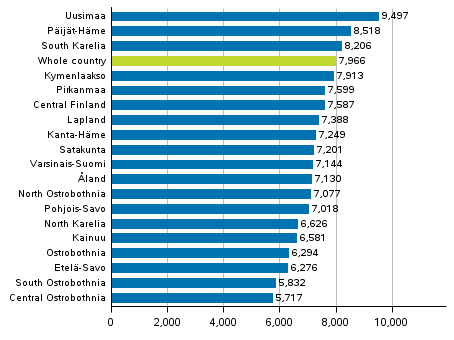
The number of identity thefts recorded was 4,000 in 2017, which is 700 cases more than in 2016. Identity theft was added to the Penal Code on 4 September 2015 and during 2015, a total of 518 cases of identity theft were reported. During 2017, a total of 1,800 identity thefts were solved.
1.2. Offences against property
In 2017, a total of 210,800 offences against property were recorded, which was 8.4 per cent lower than the year before. Among offences against property, theft offences (theft Penal Code, Section 28, Paragraph 1, aggravated theft Section 28, Paragraph 2, and petty theft Section 28, Paragraph 3) formed the biggest group. In all, 125,400 of them were reported, which was 4.6 per cent fewer than one year previously. The number of theft offences has mainly been falling throughout the 2000s. The number of thefts (Penal Code, Section 28, Paragraph 1) recorded in 2017 was 60,150, or 6.1 per cent fewer than one year before. The recorded number of aggravated thefts (Penal Code, Section 28, Paragraph 2) was 2,900, which was 13.5 per cent fewer than in 2016. The number of petty thefts (Penal Code, Section 28, Paragraph 3) recorded was 62,400, which was 2.5 per cent lower than in 2016. One-third (44,900) of all theft offences were thefts and petty thefts from shops. Compared with 2016, the number of thefts from shops fell by 4.1 per cent.
The number of burglaries (thefts, aggravated thefts or petty thefts through unlawful breaking in) reported was 29,800, which was 10.5 per cent fewer than in 2016. The number of break-ins into free-time residences increased by 23.2 per cent. A total of 1,500 of them were reported in 2017. The number of break-ins into free-time residences fluctuates considerably by year, for example, in 2014, they numbered 1,840. Breaking into residences went down by 20 per cent from the previous year. A total of 3,260 of them were recorded. Breaking into a motor vehicle decreased by 11.6 per cent.
Figure 2. Burglaries, %
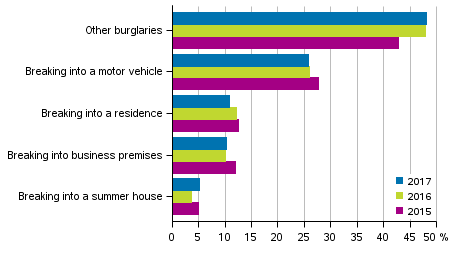
One-sixth of property offences were damages to property. In all, 33,500 of them were recorded, which was 4.9 per cent lower than in 2016. The number of damages to property has been on the decline for the past few years. Good one-half of damages to property were committed in public places.
The number of frauds (fraud Penal Code, Section 36, Paragraph 1, petty fraud Section 36, Paragraph 2, aggravated fraud Section 36, Paragraph 3) recorded was 23,400, which was 6.7 per cent fewer than in 2016. Frauds make up around one-tenth of offences against property. In all, 6,700 means of payment frauds were recorded, which was 55.9 per cent fewer than in 2016, when there were exceptionally many such cases. The number of both frauds and means of payment frauds has mainly been growing over the past ten years.
In 2017, a total of 1,230 accounting and debtor offences were recorded, which was one per cent lower than in 2016. Forgery offences (forgery, petty forgery, aggravated forgery, possession of forgery materials Penal Code, Section 33, Paragraphs 1 to 4) recorded was 2,000, which was 23.2 per cent down on 2016. The number of recorded forgery offences has been declining almost throughout the 2000s. In 2010, a total of 4,600 of them were recoded and in 2000 a total of 6,200.
The number of robberies reported was 1,640, which was two per cent fewer than in 2016. Of the robberies, 16.1 per cent were aggravated. Of the robbery offences, 1,180, or 72 per cent, took place in a public place in 2017.
Figure 3. Offences against property
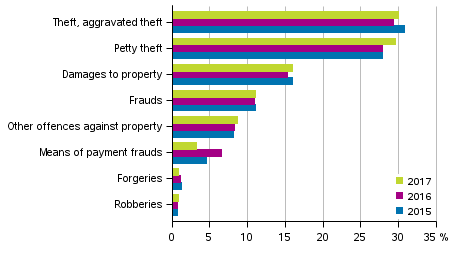
The number of thefts of use of a motor vehicle (Penal Code, Section 28, Paragraph 9) has nearly halved since 2010. Growth has occurred mainly in the number of thefts of motorcycles: up by 11 per cent compared to 2016 and by 18 per cent compared to 2010.
Table 1. Objects of thefts of use of a motor vehicle (Penal Code, Section 28, Paragraph 9) in 2010 to 2017
| 2010 | 2011 | 2012 | 2013 | 2014 | 2015 | 2016 | 2017 | |
| Total | 8,786 | 9,464 | 6,821 | 6,126 | 5,953 | 5,887 | 5,253 | 4,868 |
| Car | 6,045 | 5,996 | 4,335 | 3,645 | 3,511 | 3,718 | 3,253 | 2,937 |
| Moped | 1,770 | 2,116 | 1,631 | 1,560 | 1,524 | 1,244 | 1,088 | 929 |
| Motorcycle | 654 | 1,021 | 629 | 656 | 681 | 722 | 694 | 770 |
| Boat/vessel | 39 | 32 | 31 | 34 | 19 | 19 | 21 | 34 |
| Other motor vehicle | 278 | 299 | 195 | 231 | 218 | 184 | 197 | 198 |
Table 2. Selected offences against property by region per 100,000 population in 2017
| Region | All offences against property | Burglaries | Unauthorised thefts of a motor vehicle | Robberies | Damages to property | Embezz- lements | Frauds, means of payment frauds |
| Whole country | 3,830 | 541 | 111 | 30 | 608 | 57 | 546 |
| Uusimaa | 5,162 | 719 | 158 | 48 | 767 | 77 | 561 |
| Varsinais-Suomi | 3,361 | 505 | 84 | 24 | 538 | 69 | 445 |
| Satakunta | 3,181 | 591 | 86 | 28 | 621 | 38 | 455 |
| Kanta-H�me | 3,222 | 451 | 70 | 17 | 607 | 38 | 544 |
| Pirkanmaa | 3,806 | 536 | 96 | 30 | 615 | 54 | 505 |
| P�ij�t-H�me | 4,134 | 731 | 142 | 25 | 600 | 45 | 858 |
| Kymenlaakso | 3,419 | 519 | 104 | 17 | 527 | 54 | 449 |
| South Karelia | 3,843 | 584 | 118 | 21 | 517 | 38 | 581 |
| Etel�-Savo | 2,433 | 477 | 95 | 12 | 448 | 34 | 381 |
| Pohjois-Savo | 2,929 | 345 | 91 | 14 | 588 | 72 | 413 |
| North Karelia | 2,553 | 255 | 56 | 10 | 465 | 38 | 336 |
| Central Finland | 3,198 | 467 | 97 | 24 | 579 | 54 | 438 |
| South Ostrobothnia | 1,820 | 248 | 37 | 14 | 341 | 35 | 334 |
| Ostrobothnia | 2,521 | 406 | 99 | 6 | 483 | 23 | 268 |
| Central Ostrobothnia | 1,921 | 169 | 29 | 17 | 407 | 35 | 209 |
| North Ostrobothnia | 3,235 | 450 | 107 | 31 | 467 | 45 | 512 |
| Kainuu | 2,813 | 249 | 52 | 17 | 647 | 36 | 433 |
| Lapland | 3,059 | 438 | 100 | 18 | 548 | 33 | 412 |
| �land | 2,492 | 339 | 79 | 21 | 733 | 62 | 123 |
1.3. Offences against the person
In 2017, a total of 33,500 assault offences (assault, petty assault, aggravated assault) were recorded, which was 200 cases (0.7 per cent) fewer than in 2016. Aggravated assaults decreased by 0.7 per cent compared to the previous year. The number recorded was 1,580. Over the past ten years (2008 to 2017), 34,900 assaults, on average, have been reported yearly. The legislative amendment, which entered into force at the beginning of 2011, considerably increased the number of assault offences recorded in 2011. After the legislative amendment, petty assaults on minors or close relatives became officially prosecutable. In 2011, the number of assault offences recorded was 40,200.
The recorded number of offences against life was 73. This was five cases fewer than in 2016. The annual average for the past ten years is 100. The corresponding figure was 129 between 1998 and 2007. The number of offences against life in 2015 included 12 murders made with terrorist intent abroad, which the Finnish police were investigating. Of the offences against life recorded in 2017, two were murders made with terrorist intent. Altogether 348 attempted manslaughters, murders or killings were recorded, which was 37 more than in 2015. When recording an offence, the line between attempted manslaughter and aggravated assault is open to interpretation, which may have an effect on the level changes visible in the statistics.
A total of 1,245 rapes (rape, aggravated rape, Paragraph 3) were recorded, which is 7.3 per cent more than in 2016. From 2008 to 2017, an average of 988 rapes were reported per year. The recorded number of sexual abuses of a child was 1,168, which is six per cent fewer than in the year before. The number of sexual harassment cases recorded was 414, which was 121 cases (22.6 per cent) lower than in 2016. Sexual harassment was added to the Penal Code on 1 September 2014. The numbers of rapes and sexual abuses of a child vary much yearly. Individual reports may include a series of incidents comprising several criminal acts.
In 2017, 66 per cent of offences against the person and 40 per cent of assault offences were committed in private dwellings. In all, 13.7 per cent of rape offences were committed in public places. The corresponding share was 15.1 per cent in 2016 and 23.5 per cent of rape offences were committed in public places in 2009. Over 60 per cent of sexual harassment cases occurred in a public place or in a public event.
Table 3. Selected violent offences by region per 100,000 population in 2017
| Region | Manslaughter, murder, killing and their attempts | Assault | Aggravated assault | Petty assault | Rape offences |
| Whole country | 7 | 415 | 28 | 165 | 22 |
| Uusimaa | 8 | 499 | 29 | 163 | 25 |
| Varsinais-Suomi | 6 | 314 | 25 | 188 | 23 |
| Satakunta | 9 | 327 | 36 | 145 | 23 |
| Kanta-H�me | 5 | 324 | 34 | 167 | 19 |
| Pirkanmaa | 8 | 377 | 27 | 193 | 21 |
| P�ij�t-H�me | 10 | 376 | 34 | 123 | 15 |
| Kymenlaakso | 7 | 399 | 25 | 151 | 33 |
| South Karelia | 3 | 256 | 14 | 180 | 16 |
| Etel�-Savo | 5 | 330 | 24 | 178 | 13 |
| Pohjois-Savo | 5 | 372 | 30 | 263 | 23 |
| North Karelia | 6 | 290 | 15 | 189 | 19 |
| Central Finland | 7 | 510 | 31 | 172 | 18 |
| South Ostrobothnia | 4 | 357 | 22 | 117 | 15 |
| Ostrobothnia | 3 | 321 | 28 | 95 | 20 |
| Central Ostrobothnia | 5 | 405 | 27 | 121 | 14 |
| North Ostrobothnia | 9 | 439 | 25 | 107 | 19 |
| Kainuu | 13 | 574 | 28 | 221 | 20 |
| Lapland | 11 | 440 | 41 | 185 | 23 |
| �land | 6 | 492 | 89 | 99 | 30 |
1.4. Offences involving intoxicating substances
In all, 27,800 narcotics offences were recorded in 2017, which was 2,700 cases (10.7 per cent) more than in 2016. The number of aggravated narcotics offences went up by 8.7 per cent from the previous year. A total of 1,280 of them were recorded. Good 60 per cent of narcotics offences are use offences. In all, 17,100 cases were recorded, which was 1,400 cases (8.6 per cent) more than in 2016.
From 2009, the figures include the offences recorded by the customs and border guard, which increases the number of narcotics offences by about one-tenth compared with narcotics offences known to the police.
Figure 4. Narcotics offences in 2013–2017
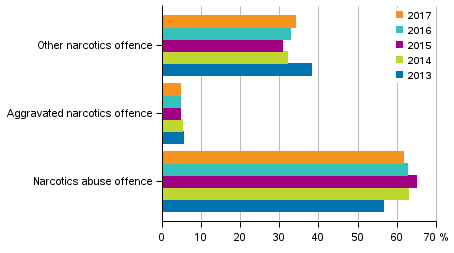
The recorded number of alcohol offences and minor alcohol offences was 1,800, which was 1,100 cases, or 37.0 per cent lower than in 2016.
When compiling statistics on offences involving intoxicating substances, offences comprising several criminal acts are entered as one. Offences involving intoxicating substances are such that they are generally found out only as a result of the activity of the police or customs and border guard officials and the majority of the offences remain undisclosed.
1.5 Drunken driving and traffic offences
Aggravated drunken driving decreased by 3.7 per cent and basic drunken driving increased by 6.4 per cent from 2016. In all, 17,700 drunken driving offences were recorded, which was 400 cases or 2.2 per cent more than in the previous year. The number of drunken driving offences recorded has primarily been decreasing in the past ten years. They have fallen by over one-third from the record figures of 1990.
Figure 5. Drunken driving offences in 1980–2017
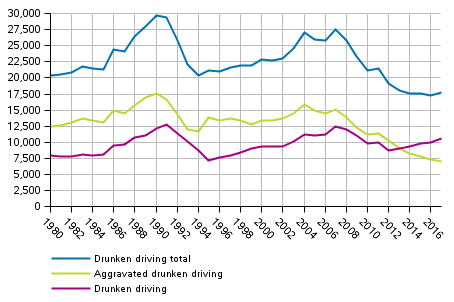
In 62.4 per cent of drunken driving cases the intoxicant was alcohol and in 32.5 per cent some other narcotic substance. The remaining 5.1 per cent had used both. Drunken driving caused by alcohol decreased by 4.1 per cent, that caused by narcotic substances increased by 14.4 per cent and the combined use of alcohol and narcotic substances grew by 14.7 per cent. More than one-half of basic drunken driving cases are caused by narcotic substances.
Figure 6. Drunken driving offences by region per 100,000 population in 2017
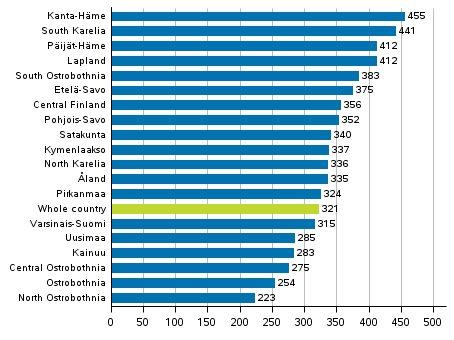
In 2017, a total of 471,200 cases of endangerment of traffic safety, traffic infractions, violations of social welfare legislation on road traffic, motor vehicle infractions and other traffic related infractions were registered, which was 14.4 per cent more than in 2016. Most of them were offences found out in connection with police surveillance and guidance. The recorded number of aggravated endangerment of traffic safety was 3,800, which was 1.8 per cent down on 2016. In total, 375,100 cases of exceeding speed limits were recorded, which was 25.3 per cent higher than in the year before. Problems connected to the re-organisation of automatic traffic control brought about a substantial fall in the number of traffic offences recorded in the early part of 2014 compared with 2013. The figures for 2013 are not fully comparable with those for 2012, because exceeding speed limits detected by automatic traffic control towards the end of 2012 were recorded in the early part of 2013.
1.6 Victims of offences
Victims of violent offences recorded in 2017 numbered 48,600, which was close on 200 more than in 2016. Of the victims, 26,400 (54.3 per cent) were men and 22,200 (45.7 per cent) women. The number of male victims was 0.1 per cent and that of female ones 0.7 per cent higher than in 2016. A total of 33,000 persons were victims of assault offences (Penal Code, Section 21, Paragraphs 5 to 7), 19,500 (59 per cent) of them men and 13,500 (41 per cent) women. Information on victims is obtained reliably only on certain violent offences.
Altogether 3,000 (9.2 per cent) of the victims of assault offences were aged 18 to 20. There were 4,400 (13.3 per cent) victims aged over 50. Assault offences directed at children aged under 18 increased by 2.6 per cent from the year before. The number of child victims was now 6,600. This is 20 per cent of all victims of assault offences. Of child victims of assault offences, 4,350 (65.8 per cent) were boys and 2,260 (34.2 per cent) girls. Compared with one year ago, the number of boys increased by 3.4 per cent and that of girls declined by 0.8 per cent. Among the child victims of assault offences, 33.7 per cent were aged under ten, 35.5 were aged 10 to 14, and 30.8 per cent were aged 15 to 17. Of the 1,070 victims of sexual abuse as a child, 87.5 per cent were girls and 12.5 per cent boys. The legislative amendment, which entered into force at the beginning of 2011, considerably increased the number of recorded assault offences. After the legislative amendment, petty assaults on minors or close relatives became officially prosecutable. In addition, at the beginning of April 2015, an amendment to the Child Welfare Act (1302/2014) came into effect, which extended the reporting obligation in cases where an offence against a child's life or health is suspected.
Figure 7. Assault offences by scene and victim’s sex in 2017
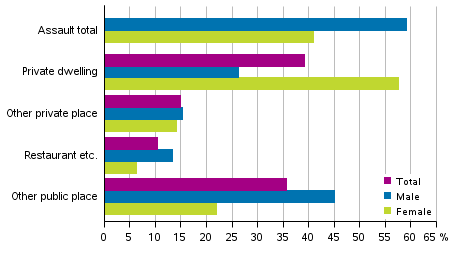
Nearly 40 per cent of assault offences were committed in private dwellings. Fifty-eight per cent of assaults against women and 26 per cent of those against men were made in private dwellings. In all, 45 per cent of assaults against men and good one-fifth of those against women took place in a public place. Ten per cent of assaults were made in restaurants.
Figure 8. Victims of certain offences by age and sex in 2017
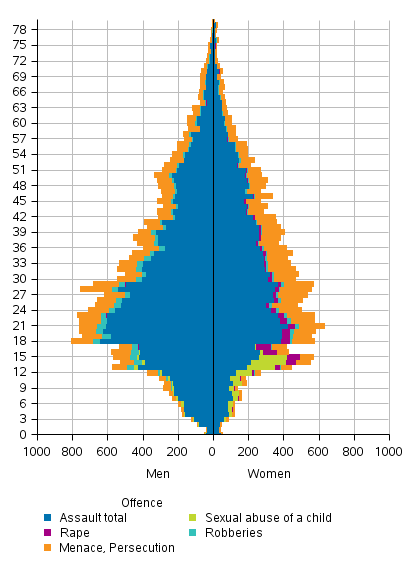
In terms of solved offences, where, in addition to the victim, the suspect is also known, the victim was of Finnish background in 91.1 per cent of cases and of foreign background in 8.9 per cent of cases. In 2016, victims were of Finnish background in 90.7 per cent and of foreign background in 9.3 per cent of cases. In sexual offences, the victim was of Finnish background in 92.4 per cent of cases, which is 2.9 percentage points lower than in 2016. In assault offences, the victim was of Finnish background in 90.5 per cent of cases, which, in turn, is 0.5 percentage points more than in 2016. There is no background data yet on persons who became part of the population during 2017, which may affect the proportions of 2017 slightly. In 2016, in all 93.4 per cent of the population were of Finnish background.
When the victim was of foreign background the suspect was also of foreign background in 52.3 per cent of cases. In 2016, the corresponding share was 58.8 per cent. When the victim was of Finnish background the suspect was also of Finnish background in 91.3 per cent of cases. In 2016, this share was 91.0 per cent. In case of sexual offences the suspect was of foreign background in 26.1 per cent of cases for victims of Finnish background. In 2016, this share was 33.1 per cent.
Table 4. Victims of certain solved offences by origin and person suspected by origin
| Victim's origin/offence | Person suspected origin | ||||||
| Origin total | Person with Finnish background total | Person with foreign background total | |||||
| 2016 | 2017 | 2016 | 2017 | 2016 | 2017 | ||
| Origin total | Total | 19,131 | 17,907 | 16,557 | 15,654 | 2,574 | 2,253 |
| Assault offences | 13,342 | 12,520 | 11,602 | 10,933 | 1,740 | 1,587 | |
| Sexual offences exc. sexual abuse of children | 574 | 501 | 378 | 360 | 196 | 141 | |
| Other offences | 5,215 | 4,886 | 4,577 | 4,361 | 638 | 525 | |
| Person with Finnish background total | Total | 17,347 | 16,306 | 15,792 | 14,891 | 1,555 | 1,415 |
| Assault offences | 12,002 | 11,332 | 11,050 | 10,390 | 952 | 942 | |
| Sexual offences exc. sexual abuse of children | 547 | 463 | 366 | 342 | 181 | 121 | |
| Other offences | 4,798 | 4,511 | 4,376 | 4,159 | 422 | 352 | |
| Person with foreign background total | Total | 1,784 | 1,601 | 765 | 763 | 1,019 | 838 |
| Assault offences | 1,340 | 1,188 | 552 | 543 | 788 | 645 | |
| Sexual offences exc. sexual abuse of children | 27 | 38 | 12 | 18 | 15 | 20 | |
| Other offences | 417 | 375 | 201 | 202 | 216 | 173 | |
Source: Statistics on offences and coercive measures 2017, Offences reported. Statistics Finland
Inquiries: Kimmo Haapakangas 029 551 3252, rikos@stat.fi
Director in charge: Jari Tarkoma
Updated 8.5.2018
Official Statistics of Finland (OSF):
Statistics on offences and coercive measures [e-publication].
ISSN=2342-9178. Reported offences, 1st quarter 2017,
1. Review on offences recorded by the police, customs and border guard
. Helsinki: Statistics Finland [referred: 21.12.2025].
Access method: http://stat.fi/til/rpk/2017/13/rpk_2017_13_2018-05-08_kat_001_en.html

